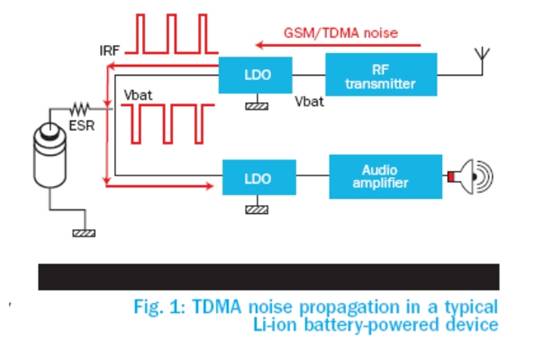This article refers to the address: http://
Regardless of whether the network used by the mobile phone is GSM or TDMA, the switching action of the RF transmitter will seriously affect the noise of the power supply because the switching frequency of the RF power amplifier is 217 Hz. The amplifier draws a large amount of current from the power supply (typically up to 1.7A) for each switch, resulting in a burst voltage drop of up to 500mV on the battery equivalent series resistance (ESR) (see Figure 1).
figure 1
For SoC designs with embedded high-resolution audio converters and audio amplifiers or highly sensitive MEMS, this change will jeopardize the overall performance of the SoC, especially if the audio quality will be severely affected and audible noise will be heard.
This noise is audible because it is not random noise. In fact, noise as low as 10 mv can be heard by the human ear if it occurs at a fixed rate. This noise is more annoying than a larger random noise.
The best way to prevent GSM noise from degrading audio quality is to use a linear regulator (LR) with very low dropout (LDO) and low output noise to power the audio amplifier directly from the Li-Ion battery. This LDO linear regulator acts as a "clean" or filter module for the amplifier's power supply.
The key criterion for choosing the best linear regulator to prevent GSM noise is the ability of the regulator to reject noise from the input voltage, expressed as the power supply rejection ratio (PSRR). However, the PSRR specification should also be considered in conjunction with the transient response and voltage drop characteristics of a linear regulator.
Power supply rejection ratio
PSRR represents the regulator's ability to keep the output voltage stable as the input voltage changes. The PSRR must be specified over a range of frequencies (including, of course, the critical 217 Hz value) and the maximum output current of the regulator design. In fact, the suppression capability must be ensured even when the regulator reaches its maximum load requirement (maximum voltage drop). Usually the PSRR performance is defined at the 10 kHz frequency point and may not accurately reflect the desired 217 Hz point noise rejection performance.
Conclusion 1: The PSRR specification must be analyzed over a complete frequency range to properly calculate the sensitivity of the regulator to any possible noise source, including 217 Hz.
Transient response and voltage drop
PSRR is not the only indicator to ensure that no noise is heard at the audio output. The transient response of a linear regulator, which is also the ability of the regulator to maintain the output voltage at an ideal stable value in the event of a power supply or load abrupt change.
Suppose Vin is the input voltage, Vout is the output voltage, and Voutreg is the stable output voltage. Here are some important points to consider:
Assume Vdrop = minimum voltage drop of the regulator (minimum differential pressure between Vin and Vout)
â—Ž The linear regulator design is designed to maintain a fixed output voltage with a high PSRR when the input voltage changes.
â—Ž When Vin > Voutreg + Vdrop, the linear regulator works normally, for example, with a 70dB PSRR output stable voltage.
â—Ž When Vin < Voutreg + Vdrop, the linear regulator no longer regulates the output voltage, Vout=Vin-Vdrop, PSRR=0dB, and the output voltage will follow the input voltage change.
Therefore, the linear regulator has a higher PSRR only when the Vin > Voutreg + Vdrop condition is met.
Consider the case shown in Figure 2, where the linear regulator provides an interface between a 3.6V Li-Ion battery and an analog module that requires a stable 2.8V voltage.

figure 2
It can be seen from Figure 2 that the 500mV transient of the battery voltage will be transferred to the LDO output depending on the effective voltage drop of the linear regulator. The linear regulator of the first row (solid blue line) has a voltage drop of less than 100mV, so it remains in regulation. In contrast, the linear regulator of the second row (red dashed line) cannot maintain such a voltage drop because it requires a voltage difference of at least 400 mV between the input and output voltages.
Conclusion 2: Linear regulators with very low voltage drops are more demanding because the battery voltage will decrease over time, for example to 2.9V. It is important to maintain a stable voltage over the entire battery voltage range, and the conclusion is that the lower the voltage drop, the longer the battery will be effectively powered.
Misunderstanding PSRR indicator
Linear regulators with a 400mV dropout are common. Even this linear regulator specifies a PSRR of 85dB, but if the input voltage is lower than 3.0+0.4=3.4V (example of the regulator in Figure 2), the regulator will not be able to filter out any noise. In this case, its actual PSRR value is 0dB!
As shown in Figure 2, the residual TDMA noise exhibited by the output of the No. 2 regulator is several hundred mV, which cannot be predicted by the PSRR indicator.
Conclusion 3: In order to evaluate the residual noise at the output of the linear regulator, the effective voltage drop must also be considered.
To help SoC designers compare two linear regulators, the voltage drop at the maximum current must be given. This ensures that the linear regulator is properly calibrated to drive the specified load and properly reject noise from the input voltage under all operating conditions.
Camping Lantern,LED Lamp,Outdoor Light
TOPCOM Lighting Co., Ltd. , http://www.lightingifts.com